Solperstine Story
My beloved grandfather, Aron Markus (“Max”) Stark, fled Germany with my grandmother in 1933, leaving behind his mother and sister. All attempts to get my great grandmother and my great aunt to the US failed, and they perished in the Shoah.
This was the sum total of what was relayed to my mother and her sister and all that we, Max’s grandchildren, knew of our family. We were not to ask any questions, ever. We knew only his mother’s name, Eidel, the Hebrew (Yiddish, actually) name that my grandfather chose for me when I was born.
My decision to research my family’s history and fate stemmed from a number of factors, but it mostly resulted from the heightened levels of introspection and inquiry that seem to accompany the onset of middle age. I spent countless hours mining Jewish genealogy databases, municipal archives of birth, death and marriage records, and myriad family tree sites. I corresponded with the Leo Baeck Institute, the German and Polish governments, the US Holocaust Memorial Museum, Yad Vashem and Jewish genealogical groups on social media. Those who do this kind of research know how difficult it is; one of the biggest challenges is that many Jewish communities’ records were destroyed during and after World War II, along with their Jewish cemeteries. This is true in my case, and my family tree is missing significant branches that may never be recovered.
Briefly, I discovered that my family’s story reads like a chapter out of “The Galitzianer Experience.” Max was born in Grodek Jagiellonski (now Horodok, Ukraine) in 1908 to Nachman (“Nathan”) Stark and Eidel (“Adele”) Lauer. The Starks had been in Grodek Jagiellonski as far back as the late 1700s; my branch of the Lauer family came from Janow (now Ivano Frankove, Ukraine), L’viv, the Czech Republic and Romania.
After the birth of Max’s sister, Reisel (“Rosa”) in 1910, the family moved to 48 Dragonerstrasse 54, now Max-Beer Strasse, in the heart of Berlin’s Scheunenviertel. Indeed, the plot to assassinate Horst Wessel was hatched in the Bar Baer, which occupied the building's ground floor.
In 1917, Nathan was killed in a trolley accident. Adele’s sister, Sara, moved from Janow to the apartment at Dragonerstrasse to help raise my grandfather and his sister. I learned that Sara married Jacob Meerfisch, lost a child, and was divorced. Adele and Rosa were expelled from Berlin in 1936. My grandfather’s best friend witnessed their execution in the streets of Katowice, when Poland fell in 1939. Sara was deported from Berlin to the Lodz Ghetto, and she was murdered at Chelmno in 1942.
In 2018, my mother and I visited Berlin. Here and there, embedded in the sidewalks and the streets, were brass cobbles. Each block had the name, birth date and fate of a victim of Nazi persecution etched into it’s surface. These cobbles are part of the Stolpersteine, or “Stumbling Stone" Project, which was created by an artist named Gunter Demnig in 1992. The commemorative Stolperstein is placed in front of the murdered individual's last freely chosen residence or business location. Many doorways had several Stolpersteine at their thresholds; entire families lost. Today, there are Stolpersteine all over Europe, and they honor not only Jewish victims, but the Romani and Sinti peoples, homosexuals, the mentally and physically disabled and others who perished at the hands of the Nazis and their collaborators.
When I returned to Rochester, I began the process for laying Stolpersteine for Adele, Rosa and Sara. I will warn the reader — there is a lot of demand and there is a wait. It took me two years just to hear back regarding my application (which is available on line). That said, once my application was accepted it took about a year to finalize our Stolpersteine. COVID certainly played a role in the delay. The September 2022 dates for my family’s Stolpersteine ceremonies were set in the Spring of that year.
My husband Michael, my mother, my children and I attended the stones’ laying in Berlin. We arranged to have a Cantor sing the Mourners Kaddish, and my girls brought flowers. A Polish friend from my genealogical work who happened to be in Berlin joined us, and we were able to share the experience via the Internet with close and distant family, the latter only recently discovered through DNA databases and sheer luck. Neighbors and Jewish students living in the area, having received notice of the upcoming ceremonies, stood with us despite the workday bustle. I remain in contact with one of the neighbors, a woman with both victims and perpetrators in her blended family.
The ceremony for Adele and Rosa was hard, but it was Sara’s that affected me most. She had spent her young adulthood helping to raise my grandfather and his sister. She bore and lost a child, and was divorced. She was living alone when she was sent to the Lodz Ghetto, and It does not appear from the Ghetto’s residency records that she was placed with anyone that she knew. The transit records from Lodz to Chelmno indicate that she died alone as well. Had we not dug into my family’s history, her story would have been lost. I mourned for every Sara that day.
Antisemitism is raging abroad, throughout the United States and here in Rochester, New York. The generation that survived or otherwise witnessed the Holocaust’s atrocities is leaving us. Preserving the stories of those who came before me simply feels like an imperative, not only for myself, my family and our Jewish Community, but to counter those who would deny our history. If we are to fulfill our obligation of Tikkun olam, I posit that preserving and retelling our ancestors’ stories and finding family are crucial first steps to making the World whole. I recall Elie Wiesel’s directive, that “[f]or the dead and the living, we must bear witness.” Never forget.
